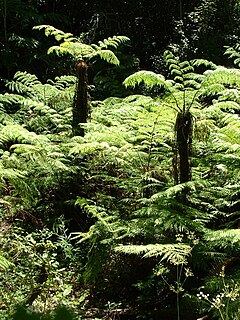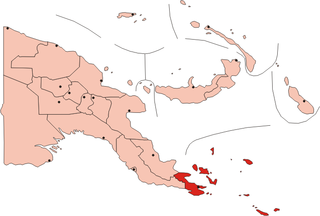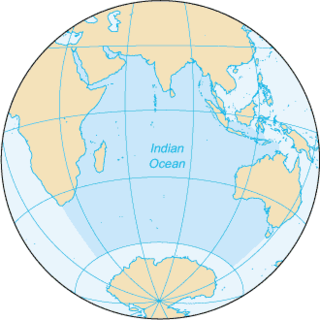
Cyathea medullaris, popularly known as the black tree fern, is a large tree fern up to 20 m tall. It is distributed across the south-west Pacific from Fiji to Pitcairn and New Zealand. It is called mamaku, katātā, kōrau, or pītau in the Māori language.
Cyathea affinis is a variable species of tree fern native to Fiji, Samoa, the Cook Islands, Austral Islands, Tahiti, and the Marquesas Islands. The trunk of this plant is erect and 2–6 m tall. Fronds are bipinnate and 2–3 m in length. The rachis and stipe are pale to brown in colour, or flushed with red towards the pinnule rachis. The stipe is sparsely covered in narrow basal scales, which are pale to dark and have broad fragile edges. Characteristically of this species, the lowest one or two pairs of pinnae may be slightly reduced and occur towards the base of the stipe. Sori are located near the pinnule midvein and are partially or fully covered by indusia, which open towards the pinnule margin.
Cyathea annae is a species of tree fern native to Ambon in the Maluku Islands, where it grows in forest from sea level to about 650 m. The erect trunk is slender and may be as tall as 3 m. Fronds are bipinnate and 1–2 m in length. Characteristically of this species, the final pair of pinnae are usually reduced and occur towards the base of the stipe. The stipe is dark, slender and covered with scattered scales. These are dark, glossy and have a pale dull margin. Fertile pinnules are normally short-lobed. Sori lack indusia and occur two to four per pinnule lobe.
Cyathea archboldii is a species of tree fern native to New Guinea and Bougainville, where it is common in submontane rain forest at an altitude of 1000–3000 m. The trunk is erect and up to about 3 m tall. Fronds are bipinnate and 2–3 m long. The rachis may be purplish and has short spines and scales. The scales range in colour from pale to brown, to bicoloured and have fragile edges. Sori occur in two rows along each side of the pinnule midvein and are covered by firm indusia.
Cyathea atropurpurea is a species of tree fern native to the islands of Luzon, Mindanao, Leyte and Mindanao in the Philippines, where it grows in forest at above 1000 m. The erect trunk is slender and may be up to 3 m tall. Fronds are bipinnate and 1–2 m long. Characteristically of this species, the final pair of pinnae are usually reduced and occur towards the base of the stipe. These, along with the stipe bases, are persistent and retained around the trunk long after withering. The stipe itself is dark and covered with scales, which are either small, dull and brown or large, dark and glossy. Sori occur near the midvein of fertile pinnules and lack indusia. Fertile pinnules are notably smaller than sterile ones.
Cyathea baileyana, also known as the wig tree fern, is a species of tree fern native to northeastern Queensland in Australia, where it grows in wet gullies and forest at an altitude of 850–1200 m. It is a rare species that is seldom found in the wild. The erect trunk is 4–5 m tall, approximately 10 cm in diameter and may be covered in stipe bases in the upper regions. C. baileyana is notable for being able to develop offshoots from the base of the trunk. Fronds are bi- or tripinnate and may be exceptionally long, up to 7 m, though they are usually around 2–3 m. The rachis and stipe are dark to darkish red, scaly and may be warty, but lack spines. Scales on the rachis and stipe are purplish brown to black and have a long hair-like apex. Characteristically of this species, the last pair of pinnae are separated from the others along the rachis and may form a clump around the trunk apex. Sori are circular and occur in one to three rows along the pinnule midvein. They lack indusia.

Cyathea brevipinna is a species of tree fern endemic to the higher parts of Mount Gower on Lord Howe Island, where it grows in exposed areas at an altitude of about 790 m. The trunk is erect and may reach 3 m in height. It is often covered with reddish brown scales and stipe bases. This species may produce stolons at ground level. Fronds are tripinnate, densely crowded, and up to about 3 m long. The stipe is brown and sometimes warty after scales fall off. The scales are long, glossy dark brown, with a distinctly narrow apex and fragile paler edges. Sori are attached to deeply divided fertile pinnules that may uncurl over the sori. Indusia are firm and large. C. brevipinna is a stunted plant with short pinnae.

Cyathea capensis is a regionally widespread and highly variable species of tree fern. It is indigenous to Southern Africa and South America.
Cyathea deckenii is a species of tree fern native to the Democratic Republic of the Congo, Tanzania and Mozambique, where it grows in wet forest at an altitude of 1350–2300 m. The trunk is erect and up to 10 m tall. Fronds are bipinnate and 2–3 m long. Characteristically of this species, the most basal one or two pairs of pinnae are reduced. The rachis and stipe range in colour from brown to dark brown or black-brown and are sparsely covered with a few scales. The scales are dark and narrow with a fragile margin of variable width. The stipe also has conical warts near the base. Sori are round and covered by large, thin indusia.
Cyathea esmeraldensis is a species of tree fern which is endemic to Ecuador. It grows in coastal forest and forested slopes of the Andes.
Cyathea exilis is a species of tree fern endemic to the Cape York Peninsula in Queensland, Australia, where it grows in vine forest on a substrate of sandstone. It is a rare plant known only from one location, specifically by a stream in Mann Creek in the William Thompson Range. In its natural habitat, C. exilis is reportedly accompanied by Pandanus and Calamus plants. The trunk is erect, up to 4 m tall and 4–8 cm in diameter. It produces several buds, often one at each stipe base. Fronds are bipinnate and up to 1 m long. The rachis and stipe range in colour from brown to dark brown or black-brown and are covered in blunt spines and scales. The scales are dull brown in colour and bear terminal setae, mostly one each. Sori are round and occur on either side of the pinnule midvein. Indusia are absent.
Cyathea fenicis is a species of tree fern native to the Philippines, Taiwan, and Orchid Island, where it grows in wet forest, forest margins and on hillsides. The trunk is erect, up to 1 m tall and about 6 cm in diameter. Fronds are tripinnate and 1.5–2 m long. Characteristically of this species, the lowest pinnae are usually reduced. The stipe is spiny and ranges in colour from brown to purple-dark brown. It bears two types of scales: long dark brown scales as well as minute brown ones. Occasionally the scales are pale. Sori are round and arranged in two rows, one on either side of the pinnule midvein. They are covered by very small indusia that resemble scales in appearance.
Cyathea recommutata is a species of tree fern native to the Malay Peninsula, central and southern Sumatra and Borneo, where it grows in acidic peaty or sandy soils in wet forest, as well as swamp forest, from sea level to an altitude of 1500 m. The trunk is erect and rarely taller than 3 m. Fronds are bipinnate and 1–2 m long. Characteristically of this species, the lowest pair of pinnae are usually reduced and occur towards the base of the stipe. The stipe itself is dark dark and bears dark, glossy basal scales with thin, fragile edges. Fertile pinnules are notably smaller than sterile ones. Sori occur near the fertile pinnule midvein and lack indusia.
Cyathea glabra is a species of tree fern native to Borneo, western Java, Sumatra and the Malay Peninsula, where it grows in lowland swamp forest and montane forest at an elevation of up to 1500 m. The trunk of this plant is erect and 2–4 m tall. Fronds are bi- or tripinnate and 1–2 m in length. Characteristically of this species, the lowest pinnae may be significantly reduced. The stipe is very dark and bears basal scales. These scales are dark, glossy and have a paler margin and fragile edges. Sori are produced in groups of one to three on fertile pinnule veins. They lack indusia.
Cyathea hancockii is a species of tree fern native to the Ryukyu Islands, Japan, Taiwan and Hong Kong. The specific epithet hancockii commemorates William Hancock (1847-1914), who collected numerous plants in Japan, China and Southeast Asia. It grows in forest, on stream banks, and in forest margins at an elevation of about 600 m or higher.
Cyathea khasyana is a species of tree fern. Its natural distribution extends from India to Myanmar, although it is absent from Sri Lanka. C. khasyana grows in forest at an altitude of 1400–1700 m. The trunk of this plant is erect and 5–7 m tall. Fronds may be bi- or tripinnate and 2–3 m in length. C. khasyana has a long, dark stipe that is covered in numerous scales. These scales are dark and have broad, pale, fringed edges. Sori are borne near the midvein of fertile pinnules and lack indusia.
Cyathea propinqua is a species of tree fern native to Fiji and possibly Samoa, where it grows in wet forest. The trunk of this plant is erect and slender, growing to 10 m in height. Fronds may be bi- or tripinnate and 2–3 m long. Dull brown scales cover the dull, dark stipe of this species. The scales are minute along most of its length, becoming thick and fleshy towards the base. Sori are borne halfway between the pinnule midvein and the edge of the lobe. Indusia are present.
Cyathea hymenodes is a species of tree fern native to the Malay Peninsula, Sumatra, and possibly Java, where it grows in montane forest at an altitude of 900–2000 m. The trunk of this plant is erect and 2–4 m tall. Fronds may be bi- or tripinnate and 1–2 m in length. The stipe may have a pair of reduced pinnae towards the base and is covered with scattered scales. These scales are dark and have very fragile edges. Sori are borne near the fertile pinnule midvein and are protected by firm, brown indusia that are saucer-like in appearance.
Cyathea junghuhniana is a species of tree fern native to southern and central Sumatra and western Java, where it grows in forest at an altitude of 1000–2000 m. The trunk of this species is erect and may be 2 m tall or more. Fronds are tripinnate and up to about 3 m long. The stipes of this species are persistent and form a skirt around the trunk. They are brown, spiny, and covered with glossy, dark brown scales. Sori are borne near the midvein of fertile pinnules and are protected by thin indusia.
Cyathea latebrosa is a common and widespread species of tree fern native to Indochina. Its natural range covers Cambodia and Thailand, and stretches from the Malay Peninsula to Indonesia, where it is present on the islands of Borneo and Sumatra. Plants reported from India and Sri Lanka have thinner indusia and may represent a separate, as-yet undescribed, species. C. latebrosa grows in a wide range of habitats, including forest, secondary forest, and plantations, from sea level up to an elevation of about 1500 m.









